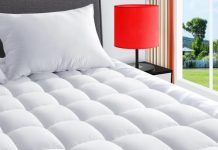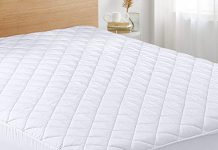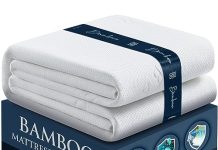In our search for the perfect bedding, we often find ourselves wondering if there are duvets designed specifically to keep us comfortable during the sweltering heat of summer or the chilly nights of winter. The answer, my friends, is a resounding yes! We are here to shed light on the world of seasonal duvets, exploring the different options available to suit our ever-changing sleep needs. So, whether you’re tossing and turning in the dog days of summer or snuggling up on a frosty winter evening, fear not – we’ve got you covered! Yes, there are duvets specifically designed for summer and winter seasons. Seasonal duvets offer the perfect solution to keep us comfortable and cozy throughout the year, adjusting to the changing temperatures and ensuring a good night’s sleep. In this article, we will explore the benefits of seasonal duvets, factors to consider when choosing one, and alternative options for seasonal bedding.
Review contents
Benefits of Seasonal Duvets
Lightweight and Breathable for Summer
During the hot summer months, we all crave a duvet that is lightweight and breathable, allowing us to stay cool and comfortable throughout the night. Seasonal duvets designed for summer are typically made from materials such as cotton or bamboo, which offer excellent breathability and moisture-wicking properties. This helps to regulate body temperature, preventing overheating and promoting a restful sleep.
Insulated and Warm for Winter
When the chilly winter weather arrives, we want a duvet that can keep us warm and snug during those cold nights. Seasonal duvets designed for winter come with higher tog ratings and are often filled with insulating materials such as down or feathers. These natural fillings provide excellent warmth and insulation, trapping the body heat and creating a cozy cocoon for a comfortable sleep.
Factors to Consider When Choosing Seasonal Duvets
Tog Rating
The tog rating of a duvet is an essential factor to consider when choosing a seasonal duvet. It measures the duvet’s ability to provide warmth and insulation. The higher the tog rating, the warmer the duvet. Typically, summer duvets have a lower tog rating (around 4.5 to 7 tog), while winter duvets have a higher tog rating (around 10.5 to 13.5 tog). It’s important to choose a duvet with an appropriate tog rating for the season, ensuring optimal comfort throughout the night.
Filling Material
Seasonal duvets are available in various filling materials, and each material offers its own unique benefits. Natural fillings, such as down or feathers, provide excellent insulation and breathability. On the other hand, synthetic fillings, like polyester or microfiber, offer hypoallergenic properties and are often more affordable. Consider your personal preferences and any allergies you may have when selecting the filling material for your duvet.
Thread Count
The thread count refers to the number of threads per square inch of fabric in a duvet. A higher thread count often indicates a finer and more tightly woven fabric, resulting in a smoother and softer duvet. While thread count is not directly related to the warmth of a duvet, it can affect its comfort and durability. Opt for a duvet with a higher thread count for a luxurious feel and enhanced durability.
Size and Fit
Choosing the right size and fit for your seasonal duvet is crucial to ensure maximum comfort and coverage. Standard duvet sizes include twin, full, queen, and king. Consider your bed size and any potential overhang or drape you prefer. A duvet that is too small may leave you feeling cold and exposed, while one that is too large may be cumbersome and difficult to manage. Be sure to measure your bed and select a duvet that fits perfectly.
Understanding Tog Ratings
Defining Tog Rating
Tog rating is a measurement used to determine the warmth and insulation provided by a duvet. It helps consumers choose the appropriate duvet for their desired level of comfort based on the season. Tog ratings typically range from 1 to 15, with lower ratings indicating lighter and cooler duvets, while higher ratings signify warmer and more insulating duvets.
Recommended Tog Ratings for Different Seasons
For a comfortable sleep during the summer, it is recommended to opt for a duvet with a tog rating between 4.5 and 7. These duvets are lightweight and provide just enough insulation to keep cool during hot nights. In contrast, for winter, a higher tog rating of 10.5 to 13.5 is recommended. These duvets offer greater insulation and help to retain body heat, ensuring a cozy and warm sleep even in the coldest temperatures.
Filling Materials for Seasonal Duvets
Natural Fillings
Natural fillings, such as down and feathers, are commonly used for seasonal duvets due to their excellent insulation properties. Down, which is the soft layer of fine feathers found under the tough exterior feathers of birds, is known for its exceptional warmth and lightweight feel. It creates a lofty and puffy duvet that traps heat effectively. Feather duvets, on the other hand, offer a slightly heavier and more affordable option while still providing excellent warmth and comfort.
Synthetic Fillings
Synthetic fillings, such as polyester or microfiber, have gained popularity in recent years due to their affordability, hypoallergenic properties, and durability. These types of filling materials are often used in seasonal duvets, providing warmth and insulation similar to natural fillings but at a lower cost. Synthetic duvets are also suitable for those with allergies, as they resist dust mites and are easy to clean.
Popular Duvet Materials for Summer
Cotton Duvets
Cotton duvets are a popular choice for summer bedding due to their exceptional breathability and moisture-wicking properties. The natural fibers of cotton allow for effective airflow, keeping the body cool and dry throughout the night. Cotton is also known for its softness and lightweight feel, providing a comfortable and gentle sleeping experience during hot weather.
Bamboo Duvets
Bamboo duvets have gained popularity in recent years due to their eco-friendly and sustainable nature. Bamboo fiber is naturally breathable, hypoallergenic, and antimicrobial, making it an excellent choice for those who are sensitive or have allergies. Bamboo duvets offer good moisture-wicking ability, ensuring a cool and dry sleep even on the warmest nights.
Popular Duvet Materials for Winter
Down Duvets
Down duvets are the ideal choice for winter nights, providing exceptional warmth and insulation. Down clusters trap air effectively, creating pockets of warmth that retain body heat. This natural filling material offers superior insulation without being overly heavy or restrictive.
Feather Duvets
Feather duvets provide a cozy and warm sleep experience during the winter months. With a higher feather to down ratio compared to down duvets, they offer more weight and density, generating a heavier and warmer feel. Feather duvets are an excellent choice for those seeking a duvet with a more substantial and snug sensation.
Thread Count and Breathability
Importance of Thread Count
Although thread count is not directly related to the warmth of a duvet, it plays a significant role in its breathability and overall comfort. A higher thread count usually indicates a tighter weave, resulting in a smoother and softer duvet. This enhances breathability by allowing air to circulate more freely, preventing overheating and promoting a comfortable sleep environment.
Choosing Breathable Fabrics
In addition to thread count, the choice of fabric can also affect the breathability of a duvet. Opt for natural fabrics, such as cotton or bamboo, as they have excellent moisture-wicking properties and promote airflow. These fabrics allow heat to escape and keep the body cool and dry throughout the night, ensuring a comfortable and sweat-free sleep.
Choosing the Right Size and Fit
Standard Duvet Sizes
Seasonal duvets are available in standard sizes, including twin, full, queen, and king, to fit a range of beds. It is essential to select the right duvet size to ensure maximum comfort and coverage. A duvet that is too small may leave you feeling cold, while one that is too large can be cumbersome and difficult to manage. Measure your bed dimensions and choose a duvet that fits properly without excessive overhang or drape.
Considerations for Bed Size
When selecting a duvet, consider the size of your bed and any specific needs or preferences. For individuals who toss and turn during sleep, a larger duvet may provide better coverage and prevent any potential exposure to cold drafts. Additionally, if you share a bed, a larger duvet can accommodate both sleepers comfortably, ensuring a cozy sleep environment for everyone.
Overhang and Drape
The overhang and drape of a duvet can impact both the aesthetic appeal and functionality of your bedding. Some individuals prefer a neat and tidy look with minimal overhang, while others enjoy a more luxurious and draped appearance. Consider your personal preference and the overall style of your bedroom when determining the desired overhang and drape of your duvet.
Maintaining Seasonal Duvets
Cleaning and Washing
To ensure the longevity and cleanliness of your seasonal duvets, it is important to follow proper cleaning and washing instructions. Most duvets can be machine washed on a gentle cycle with a mild detergent. However, it’s crucial to check the care label for specific instructions, as some duvets may require professional dry cleaning. Regular cleaning helps to maintain the freshness and functionality of the duvet, ensuring a comfortable sleep experience.
Storage Tips
When storing seasonal duvets during the off-season, it is best to keep them in a cool and dry place to prevent any moisture buildup or damage. Use a duvet storage bag or a breathable fabric cover to protect the duvet from dust and pests. Avoid compression or folding, as this can affect the loft and insulation of the duvet. Proper storage ensures that your seasonal duvets remain clean, fresh, and ready for use when the next season arrives.
Alternative Options for Seasonal Bedding
Using Duvet Covers
One alternative option for seasonal bedding is to use duvet covers. Duvet covers are removable and can be easily changed to match different seasons or personal preferences. They provide an extra layer of protection for your duvet, reducing the need for frequent washing of the duvet itself. Duvet covers are available in a wide range of designs, colors, and materials, allowing you to easily switch up your bedding style while keeping your duvet clean and protected.
Layering Bedding with Blankets or Throws
Another option for seasonal bedding is to layer your duvet with blankets or throws. This allows for greater flexibility in adjusting the warmth and insulation based on personal preference and changing weather conditions. Layering with lightweight blankets or throws during the summer provides additional comfort without overheating, while adding thicker blankets during winter ensures extra warmth and coziness. This customizable approach to bedding allows you to create the perfect sleep environment year-round.
In conclusion, seasonal duvets offer the convenience and comfort of adjusting to the changing temperatures throughout the year. Lightweight and breathable duvets are perfect for summer, while insulated and warm duvets are ideal for winter. Consider factors such as tog rating, filling material, thread count, size, and fit when choosing the right seasonal duvet for your needs. Proper maintenance and storage ensure the longevity of your duvets, while alternative options like duvet covers and layering bedding provide flexibility and versatility. With the right seasonal duvet, you can enjoy a comfortable and restful sleep, no matter the time of year.



























